Blog / December 2007
-
28 December 2007Trinity : Adding sentences and vocabulary
I hope everyone had a nice Christmas and the New Year is shaping up good! I'll be off for the weekend to practice my abysmal German skills in Aachen where one of my friends relocated.
Here's a few more screenshots of what I have been working on, if you read again the news from 5 December Working on the next big update... hopefully it should make more sense now.
Continue reading for screenshots...This is the Trinity "landing" page, where you can see your current progress in the 3 main areas : sentences, vocabulary and kanji.
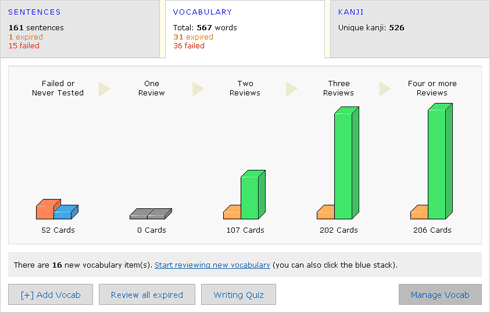
Each one of the 3 big tabs contains a summary of the progress, clicking on the tabs shows the flashcard status for Sentences and Vocabulary, and for Kanji it shows various statistics about the kanji covered by the Sentences and Vocabulary.
Adding a sentence...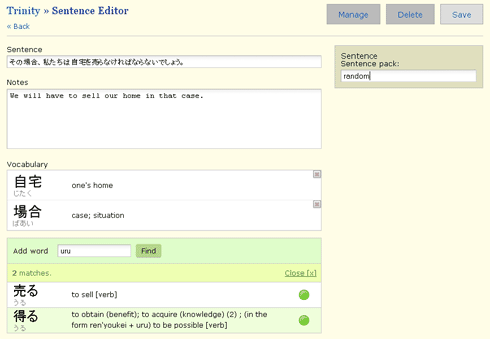
Creating a vocabulary list is very similar to adding sentences, the sentence becomes the vocabulary list title, and the notes here are a description for the list (which may be useful when sharing vocab lists) :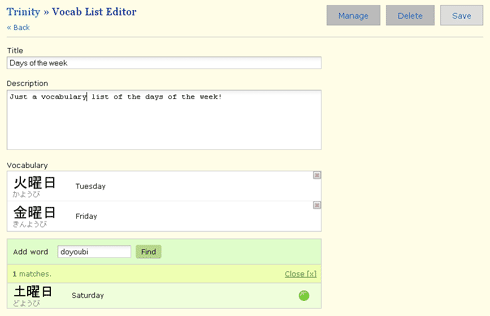
One of the things that came out really well is that entering vocabulary items works exactly the same way whether it is a sentence, a vocabulary list, or exemplary compounds added from the kanji page :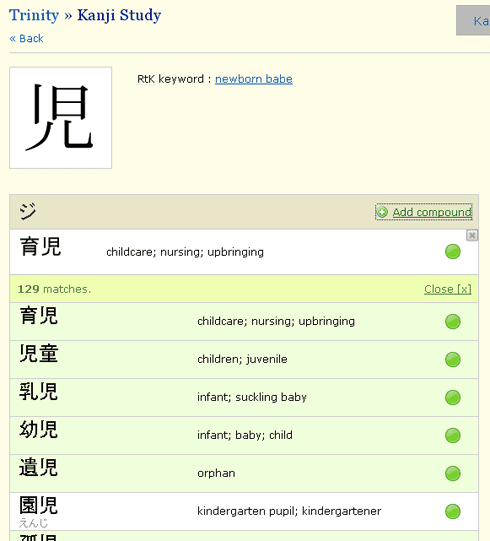
Vocabulary items added in any of those 3 ways ends up as flashcards that are reviewed in a similar way to the RtK kanji reviews.
Over time I want to add some icons to the vocabulary lookup system, to indicate verbs, adjectives, etc. Any improvements to the lookup will then work for Sentences, Vocab lists and Exemplary compounds. The trick will be to figure out what information is really relevant and needs to be seen first.
So as you can see you can end up with vocabulary flashcards through adding sentences, or adding vocab lists, or adding exemplary compounds... or all three :)
Having only one, simple method for entering vocabulary accross the site I think goes a long way to make it user friendly. Another thing is I try to make each screen/webpage have a single purpose.
On paper, the idea is that sentences provide context for vocabulary, and vocabulary (kanji compounds) provide context for the Japanese characters. Each one is a part of the whole, that's the idea behind the name. Or maybe I'm over thinking it ;) -
26 December 2007Kanji chains, memory palaces, oh my!
If you browse the forums you may have read some of my ramblings about kanji chains and memory palaces. I have been really interested in the subject of memory palaces and other mnemonic techniques ever since completing RtK Volume 1.
Mnemonic techniques such as kanji chains and memory palaces (which work relatively similar) are difficult to explain, they seem so simple when you use them, but take a while to explain, since it's mostly mental tricks.
About two weeks ago I toyed once again with the idea of creating a visual interface to build kanji chains. I started seeing it working and got really excited so I wrote a very simple "proof of concept" page.
Continue reading for screenshots...The first thing to do is to come up with a simple mnemonic, which will tie all characters in the chain to the sound. In this case I didn't even create a mnemonic but simply started the story with a couple guys living in a dormitory and just remembering that "dormitory" is pronounced リョウ.
This is what the completed chain looks like. Because they are all pronounced the same way, you can learn to read them all at once very effectively.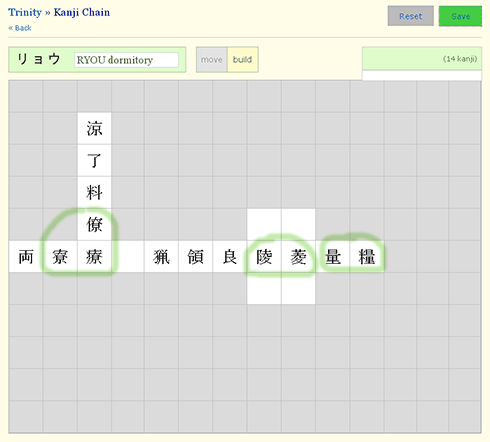
As you can see it's fairly simple : you start with a list from which you drag and drop characters onto the grid. Placing characters on the grid creates spatial relation ships between the items to memorize. As you place the characters you try to come up with a random plot, a simple story line that binds the characters together, by using the english keywords. When all characters are placed on the grid and connected in some way, it becomes like a map, and by following the chains (sometimes multiple ones), you can retrace the story in your mind.
I have highlighted an important feature of the "kanji chain" technique, which is very apparent once you place down the characters : you become immediately acquainted with those "signal" components that indicate the sound. In the screenshot above you can see three groups of characters that share a component : 僚 寮 療, 陵 菱, and 量 糧.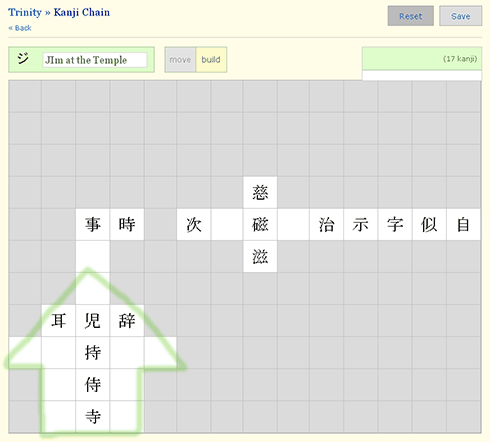
This second screenshot illustrates the possibility also to emphasize the "memory palace" approach, where you look at the grid as a map to an imaginary place (bird's eye view or sideways view for example). This takes advantage of our spatial memory.
This emphasizes spatial relationships between items, and also breaks down large groups (30 to 60 characters or even more) into smaller chunks that are easier to remember. On the screenshot I have highlighted the crude drawing I did in the shape of a temple : the story begins with a man named JIM (ties in the reading ジ) who works as a "waiter" 侍 in a "temple" 寺 where he "holds" 持 a "newborn babe" 児, etc. etc. The rest of the story, as it does in most kanji chains, unfolds along an imaginary road composed of japanese characters.
Creating the map/kanji chain of course requires some effort, the most annoying really is to come up with the basic mnemonic to tie to the chinese reading. Once you've got that, the rest is fairly easy. As you start playing around with the characters and a story shapes up in your mind, you re-arrange characters around, swap them around until it fits "right", just doing this already starts the process of linking the characters in your memory. Most importantly, it's fun.
The technique really becomes complete once you go to the "Kanji Study" page for each of the characters in the chain, and lookup exemplary compounds:
For each character, the possible chinese and japanese readings are shown (chinese readings are in katakana). Click add compound and a list of all possible matches appears. Clicking once in the drop down list will add a vocabulary flashcard, and will also continue to show the compound permanently on this kanji's page. In fact every item of vocabulary you have that happens to use this character with the given reading will appear in the list.
Compounds are listed roughly in order of frequency. The real highlight here is that as I scroll down the list, I can go and pick a compound that I can read because I recognize the other characters! The furigana only appears when you point at the compound, to encourage you to read and recall.
Here I know how to read 遺 (from a previous kanji chain!), so after creating the chain for ジ I can immediately read the compound 遺児 【いじ】 which means "orphan". Remembering the compound is fairly easy thanks to the keywords, as most of learners completing RtK1 have already experienced, kanji compounds become mnemonic puzzles : here the orphan is a "bequeath'ed newborn babe". I could also add a handful of other compounds, in fact with a few hundred kanji under your belt you get many combinations which means it is often possible to select exemplary compounds made of previously leanred characters plus the newly learned character. In a way, this is similar to Remembering the Kanji Volume 2, but you can study group of readings in any order you like.
I didn't get much time lately to work on the site, with Christmas, New Year and all :) So I am taking this time to test the system, I make a point not to actively visualize anything, I don't close my eyes, I even do a few groups when I'm tired ! Just to see how well they hold. The feeling is similar to doing RtK1, newly learned chains seem blurry in your memory until you add compounds and start reviewing the exemplary vocabulary. First reviews always require effort, at the same time it seems like you're deciphering readings rather than actually reading the whole meaning, since now you are reviewing an actual word too. But soon enough after a couple reviews, the sound of the word becomes familiar, and the meaning and reading comes quicker.
Finally there is the OnYomi page where you will be able to track your overall progress. This is where you can choose a on yomi group, see the related characters, go to the kanji study page for each character, and go to the kanji chain page for each group.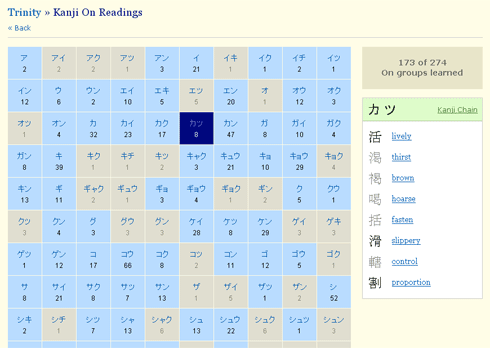
This page is not finished yet, the light blue boxes are groups within which I have at least one exemplary compound. Ideally this will show a different colour for completed groups.
I like to think of that big grid of chinese readings as the china wall ;)
-
20 December 2007Registration problem
If you tried registering on the website from December 12 up to today, you will have seen an error message. Several users have tried registering multiple times with various usernames and passwords. This was a problem with the "automatic" forum registration though, and your main site registration was fine.
If you happened to create a user account last week, try to log in and it should work. If you want to participate in the community forums, drop me a quick mail and I will create your account on the forum so you can log in the forums with the same username.
Sorry for the trouble. -
12 December 2007Pick your kanji avatar
I fooled around a little yesterday and added an option into the Forum > Profile > Personality : "Create kanji avatar". If I fool around again, maybe I'll create some custom backgrounds for it :) Have fun!
Note: If you DO have an avatar picture already, just be aware that your image will be replaced, so if you want to change it back you'll need to restore it with the "Change avatar" option. -
8 December 2007Update to Review Summary page
Thanks to a recent suggestion from ivoSF I realized the Review Summary page really needed some brushing up. I hope you like the new version!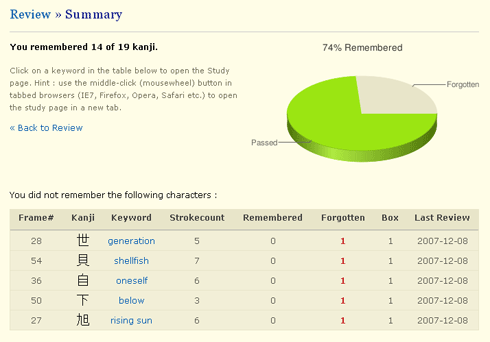
Just recently, a friend sent me a link to the excellent Google Chart API. The charts are really clear and simple to read and I thought it would fit in nicely on the site. I will definitely look at other ways to use it in the future.
You may have noticed also the title of the page changed into a small "breadcrumb" type of navigation, which is not the same for the rest of the site. This is in fact the structure that I use in the area in-the-works, so eventually it will be the same on all pages. -
5 December 2007Working on the next big update...
The last few months I've been working on a new area for the website. I've nicknamed the new area "Trinity" for now, for lack of a better name, because it is split in 3 mains areas : Sentences, Vocabulary and Kanji.
On the "landing" page for this new section, there are 3 big tabs giving you overviews of your current progress into each area. The first two show a graphic of your stacks much like the current review area while the third gives your statistics on your knowledge of kanji & readings.
Adding vocabulary is a breeze : simply type the word into a search box using romaji, kana or kanji, or a mix of the three :) A list appears with all matching compounds and a single click adds the item to your sentence, or vocabulary list. No need to manually enter the kanji, reading (furigana) and definition.The dictionary lookup will be courtesy of Jim Breen & EDRDG's JMDICT project).
When you review sentences, you can see the attached vocabulary after flipping the card.
Likewise, when you review vocabulary, you can click a link to see the sentence(s) and/or vocabulary list(s) in which the word appeared.
This effectively means you can expand your vocabulary through adding sentences, and review this vocabulary separately later (both sentences and vocabulary items are on scheduled flashcards). Or you could just review vocabulary lists, or both, and there's still another way to add vocabulary...
The kanji section first takes you to the "onyomi" page where you can see an overview of your progress on the chinese readings. It looks similar to the "progress chart" page, with one box per reading, the number of characters falling under that reading, and a different colour for any of the groups you are currently covering with your vocabulary!
Clicking any of the readings gives you a list of all kanji that have this reading, and clicking any of those kanji will take you to the "kanji" page. I think you will love the Kanji page : it shows you any vocabulary in your sentences/vocablists that matches the character, plus any other exemplary compounds you have added from this page... simply click "add compound" and you will get a list of Japanese words that match the character/reading combination. This is a great way to expand your vocabulary. If you combine this with the "onyomi" page you can get exemplary compounds for each character and learn the reading for a bunch of characters in one swoop, much more efficiently than if you had picked up the readings haphazardly.
Of course, you can combine the best of both worlds : create sentences and vocab lists from your preferred material; then look at what new kanji readings have been learned, and complete those groups of characters by adding more exemplary compounds for other characters that use the same readings you have currently learned :)
It's important to me that this new area will be open to all Japanese learners, whether they use RtK or not. For non-RtK learners, it's great because you you can go the Kanji page and add exemplary words for a subset of characters you know, any characters, any order you like.
But with that said, I think RtK learners will really shine at this new learning tool, as with the writing of the characters already taken care of, you will be able to add vocabulary at a much greater pace than if you had to learn the writing at the same time. Not only you can add exemplary words for any character, but you could also lookup the words on a Japanese search engine, and enter example sentences you've found to cover this vocabulary.
I am trying lately to prioritize my to-do list and get the program into a "beta" state that will be testable online. I can not give any date yet though.
By Month
- Mar 2025 (1)
- Nov 2024 (1)
- Sep 2024 (1)
- Jun 2024 (2)
- May 2024 (4)
- Apr 2024 (3)
- Mar 2024 (1)
- Feb 2024 (1)
- Dec 2023 (1)
- Nov 2023 (2)
- Oct 2023 (2)
- Apr 2023 (2)
- Mar 2023 (2)
- Feb 2023 (1)
- Jan 2023 (2)
- Dec 2022 (1)
- Nov 2022 (2)
- Oct 2022 (3)
- Sep 2022 (1)
- May 2022 (4)
- Apr 2022 (1)
- Feb 2022 (2)
- Jan 2022 (2)
- Dec 2021 (4)
- Nov 2021 (2)
- Oct 2021 (2)
- Sep 2021 (2)
- Aug 2021 (1)
- Apr 2021 (2)
- Feb 2021 (3)
- Jan 2021 (3)
- Dec 2020 (1)
- Nov 2020 (1)
- May 2020 (1)
- Apr 2020 (1)
- Jan 2020 (1)
- Oct 2019 (1)
- Sep 2019 (1)
- Aug 2019 (4)
- Jul 2019 (3)
- Jun 2019 (1)
- May 2019 (1)
- Mar 2019 (2)
- Jan 2019 (1)
- Nov 2018 (3)
- Oct 2018 (8)
- Sep 2018 (4)
- Aug 2018 (3)
- Jul 2018 (1)
- Jun 2018 (4)
- May 2018 (1)
- Apr 2018 (1)
- Mar 2018 (1)
- Jan 2018 (1)
- Dec 2017 (6)
- Nov 2017 (4)
- Oct 2017 (4)
- Sep 2017 (5)
- Aug 2017 (5)
- Jun 2017 (3)
- May 2017 (2)
- Apr 2017 (3)
- Mar 2017 (7)
- Feb 2017 (10)
- Jan 2017 (11)
- Dec 2016 (6)
- Nov 2016 (5)
- Oct 2016 (6)
- Sep 2016 (7)
- Aug 2016 (3)
- May 2016 (1)
- Mar 2016 (2)
- Jan 2016 (1)
- Dec 2015 (3)
- Nov 2015 (1)
- Oct 2015 (1)
- Sep 2015 (7)
- Jul 2015 (2)
- Jun 2015 (1)
- May 2015 (5)
- Apr 2015 (4)
- Mar 2015 (5)
- Feb 2015 (4)
- Jan 2015 (5)
- Dec 2014 (4)
- Nov 2014 (3)
- Oct 2014 (2)
- Jun 2014 (1)
- Apr 2014 (2)
- Mar 2014 (4)
- Feb 2014 (3)
- Jan 2014 (4)
- Dec 2013 (2)
- Oct 2013 (1)
- Sep 2013 (1)
- Jun 2013 (4)
- May 2013 (1)
- Mar 2013 (1)
- Jan 2013 (2)
- Oct 2012 (2)
- Aug 2012 (1)
- Jul 2012 (2)
- Jun 2012 (2)
- May 2012 (1)
- Mar 2012 (2)
- May 2011 (1)
- Apr 2011 (4)
- Mar 2011 (3)
- Feb 2011 (2)
- Jan 2011 (2)
- Dec 2010 (8)
- Nov 2010 (8)
- Oct 2010 (3)
- Sep 2010 (3)
- Aug 2010 (1)
- Jul 2010 (2)
- Jun 2010 (5)
- May 2010 (1)
- Apr 2010 (3)
- Mar 2010 (4)
- Feb 2010 (2)
- Jan 2010 (1)
- Dec 2009 (5)
- Nov 2009 (5)
- Oct 2009 (1)
- Aug 2009 (1)
- May 2009 (5)
- Apr 2009 (2)
- Mar 2009 (1)
- Feb 2009 (2)
- Jan 2009 (2)
- Nov 2008 (1)
- Oct 2008 (1)
- Sep 2008 (1)
- May 2008 (2)
- Apr 2008 (1)
- Feb 2008 (6)
- Jan 2008 (5)
- Dec 2007 (6)
- Oct 2007 (1)
- Sep 2007 (2)
- Aug 2007 (3)
- Jun 2007 (1)
- May 2007 (5)
- Apr 2007 (1)
- Mar 2007 (2)
- Feb 2007 (1)
- Jan 2007 (4)
- Dec 2006 (3)
- Aug 2006 (1)
- Jun 2006 (3)
- Apr 2006 (6)
- Mar 2006 (8)
- Feb 2006 (1)
- Jan 2006 (4)
- Nov 2005 (1)
- Oct 2005 (4)
- Sep 2005 (1)
- Aug 2005 (11)
